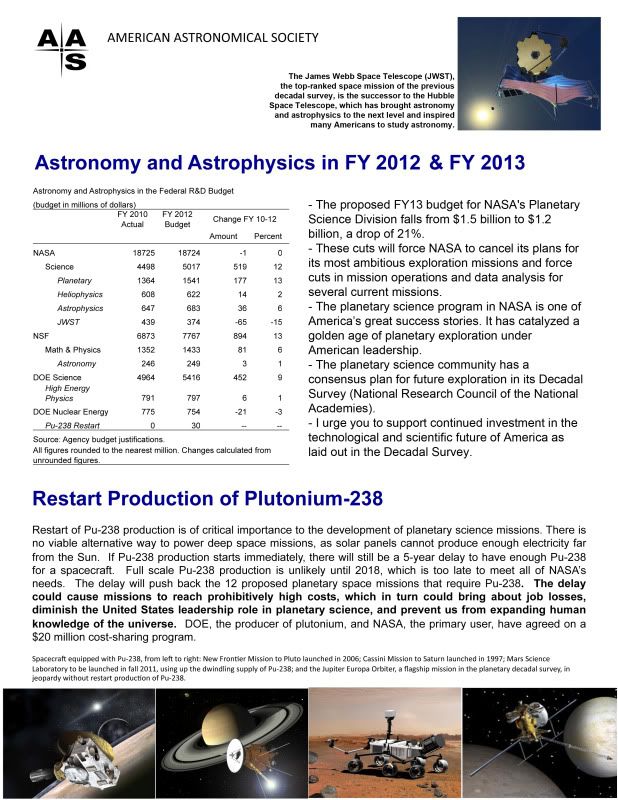At the start of
2012, I was just beginning to develop my love for space policy. I had
joined the American Astronomical Society's Division for Planetary
Sciences' Federal Relations Subcommittee two years prior, but I had
played a background role. I was thrilled when I was selected by AAS
to participate in their Communicating with Washington program. My
focus: restarting production of plutonium-238 for planetary science
missions and addressing the proposed planetary science budget cuts
within NASA.
Using a combination
of AAS and DPS literature, I pieced together a flyer to give to those
I met with in our nation's capital. I thought it a shame that the DPS
FRS was dysfunctional at the time and therefore did not provide me
with any assistance or advice regarding the advocacy visit, looking
back, it may have been a good thing. I was forced to learn on my own
how to schedule and prepare for congressional visits and how to
interact with legislators and staffers. This experience helped me
tremendously with my future Tallahassee visits with Florida Space
Day, which I joined in 2013.
 |
| The leave-behind flyer I made for my Washington, D.C. visit |
Pu-238, a
radioactive isotope of the chemical element plutonium, is not a
product for or from weapons. It is made from an entirely
separate process for a separate purpose, a peaceful purpose of scientific exploration. It is used as the heat source
in radioisotope thermoelectric generators which power space missions
such as Voyager 1 and 2, Cassini–Huygens to Saturn, New Horizons to
Pluto, and the Mars Science Laboratory/Curiosity. Pu-238 will also
fuel Curiosity's twin, Mars 2020.
However, Pu-238
stockpiles are very low, so low that the scarcity risks future
planetary missions. After the United States stopped making Pu-238 in
1988, we had to rely on the Russian supply, which was also running
out. In 2012, there was widespread agreement that Pu-238 production
should restart in the U.S. but there was disagreement about which
government agency should pay for it and how the supply would be
allocated.
 |
| Playing tourist at the White House - March 2012 |
 |
| Cherry blossom season at the tidal basin - March 2012 |
My first meeting in
Washington, D.C. was with a recent physics PhD who worked in the
Office of Management and Budget. He helped to craft the proposed
FY2013 NASA budget and thought it firm and decided. He was most interested in budget allocation
within NASA: which programs should be funded and which should be cut.
He was very interested in my graduate research and my future goals as
well.
I then met with two
members of the House of Representatives Committee on Science, Space,
and Technology, Subcommittee on Space & Aeronautics. From the
House side, the FY13 budget was very fluid compared to the OMB point
of view. Their largest priority from what I could tell was
maintaining U.S. leadership in space exploration.
 |
| Fun times at the House of Representatives - March 2012 |
My meetings the
following day were Florida-specific. I met with a NASA fellow from
Senator Bill Nelson's office on loan from Kennedy Space Center. He was very concerned about the
proposed planetary science budget cuts and was curious to learn of
their extent. He seemed to want to take immediate action to reverse the negative effects of the budget cuts.
Unfortunately, my
very brief meeting with Senator Marco Rubio's office was unproductive
and the staffer I met with gave me no indication that he or the
senator cared about the issue or about NASA. Whether his stance has
changed since launching his presidential campaign, I don't know.
My favorite meeting
was with Congressman Bill Posey and his staff. Our meeting was
extensive and productive. The congressman is undoubtedly very
pro-space. Although my conversation with the congressman was
NASA-broad and we didn't delve much into specifics, my post-meeting
with a staffer in the hallway was very interesting. It was the first
of many interactions I'd have with my congressman and his office.
 |
| Meeting Congressman Bill Posey - March 2012 |
My final meeting was
with Congresswoman Sandy Adams' office, whose district at the time
included Kennedy Space Center. The staffer who I met with was a
recent graduate of my university and was even aware of my specific
planetary science lab. The office was very pro-space and assured me
that the FY13 budget was being massaged.
Although NASA
received a budget cut that year in relation to the president's FY13
request, planetary science did receive a tiny budget bump up from the
initial request. Planetary science receive even more of an increase
in the following year. Although NASA's budget dropped in 2013, it's
been on a slight rise since then, though most expect the numbers to
continue to fluctuate.
Pu-238 production
was restarted to a small degree in 2013, but not nearly enough. A
series of articles have been published in the last few weeks about
the need for more for the future of NASA's planetary exploration
future. New product is expected to be available in 2019, but not as
much as the projected demand. The budgets aren't high enough for
faster or increased production.
Future planetary missions that can't rely on solar
power may be delayed, descoped, or doomed. Otherwise great science missions may be otherwise stuck in limbo without a fuel source. I can only hope that our current
legislators take a long view on the need for the Pu-238 program so that we
can continue our very successful planetary science missions well into
the future. Bring on more Mars rovers, Pluto probes, and other planetary achievements!
 |
| Celebrating past space achievements and working toward future ones at the Smithsonian Air & Space Museum - March 2012 |

No comments:
Post a Comment